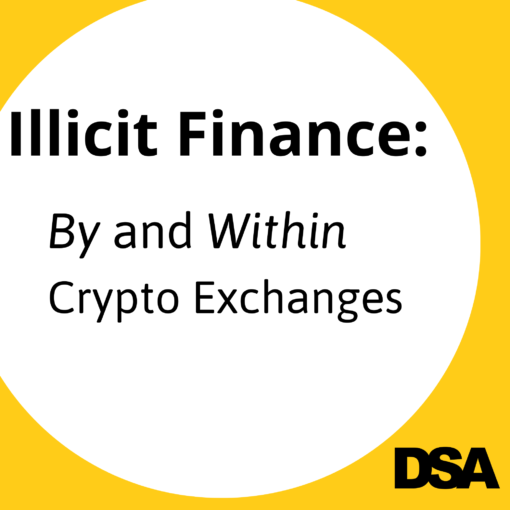Summary: The United Nations Office on Drugs and Crime published a report titled “Casinos, Money Laundering, Underground Banking, and Transnational Organized Crime in East and Southeast Asia: A Hidden and Accelerating Threat.” Alison Jimenez’s analysis of cryptocrime estimates were referenced in the UN report.
Transnational Organized Crime Revenue Dramatically Grows
The UN report found:
“The acceleration of global crime networks centered in the Mekong aided by technology has dramatically expanded criminal revenue streams. This has necessitated a revolution in the regional underground banking architecture, resulting in the development of systems and infrastructure capable of moving and laundering massive volumes of state-backed fiat and cryptocurrencies.”
Challenges Assessing Transnational Organized Crime’s Use of Cryptocurrency
The UN report discusses the challenges of estimating cryptocurrency flows to Transnational Organized Crime groups.
“It is worth noting that cryptocurrency flows connected to organized crime have been cited as vastly underestimated by industry experts [22] as well as law enforcement and regulatory authorities in the region.
Experts have pointed to a number of shortcomings related to existing analyses including massive gaps in crime attribution on the blockchain, fabricated reporting by crypto exchanges, and the prevalence of wash trading which inflates crypto transaction volumes, thereby shrinking the portion of illicit transactions identified.”
The UN report cites a moneylaundering.com article by Koos Couvee titled “Cryptocurrency Research Firms Vastly Underestimate Illicit Payments, Critics Claim.”
DSA president, Alison Jimenez, was quoted in the moneylaundering.com article cited by the UN several times including:
Cryptocurrency Crime within Exchanges is Excluded
- “The vast majority of crypto transactions…occur within exchanges” while the cryptocrime estimates exclusively add up illicit transactions on the blockchain. Therefore, crimes within exchanges are NOT part of the estimates.
- If the total volume of crypto transactions is an iceberg, “Just 10 percent is above the waterline [recorded on the blockchain], the rest is recorded on internal ledgers of crypto exchanges, which have in some case been found to be sloppy or outright fraudulent”.
Leveraged Trading Maximizes “Transaction Volume”
- “In crypto, you can have extreme amounts of leverage that makes the total transaction volume really big, while illicit activity like ransomware payments don’t involve leverage”.
Want to Lose a Needle? Create a Bigger Haystack.
- Wash trading inflates crypto transaction volumes…which magically shrinks the illicit portion of “all crypto transactions”.
House Financial Services Written Testimony
Ms. Jimenez further discussed the limitations of blockchain analytics in her written testimony before the House Financial Services Sub-committee on Digital Assets:
Limits of Blockchain Transparency
Many bad actors have changed how they transact with cryptocurrency on the blockchain to limit exposure to blockchain analytics and tracing.
On-chain obfuscation methods include:
- Using mixers
- Using De-Fi protocols as a mixer
- Transacting on “layer 2” protocols such as the bitcoin Lightning Network
- Hopping from one blockchain to another
- Creating new ‘clean’ wallets or addresses for each on-chain transaction
- Using privacy-enhanced cryptocurrencies
- Selecting blockchains with enhanced privacy features
Challenges to On-Chain Attribution
Attribution of a wallet address to a specific person or entity is challenging, especially for the private sector who lack access to off-chain data available to law enforcement or intelligence agencies.
Additionally, blockchain analytic firms do not always reach the same conclusions regarding attribution even when they are working from the same blockchain data. Finally, the attribution and tracing methodology used by blockchain analytics firms is often proprietary and unaudited.
Cryptocurrency Exchanges Internal Transactions Escape Blockchain Analytics
If all cryptocurrency transactions were an iceberg, the crypto transactions subject to blockchain analytics is the small portion above the waterline.
Most cryptocurrency transactions occurwithin crypto exchanges. Crypto exchanges internally match buyers and sellers. Exchanges also act as market-makers, stepping in as a counterparty when a buyer/seller is unavailable. These off-chain transactions escape traceability and blockchain analytics.
Researchers estimated that bitcoin transactions within exchanges to be ten times the volume of transactions executed on the blockchain:
On-chain transactions, however, constitute only a small share of the universe of all Bitcoin trades, most of which are “off-chain” utilizing some form of exchange, some heavily regulated, some not so much.[9]
Internal Ledgers at Crypto Exchanges.
A crypto exchange’s internal transactions are not recorded on the blockchain.Instead, these off-chain transactions are recorded on the exchange’s internal ledger.
Bad actors can use cryptocurrency but evade creating a blockchain record of transactions by simply conducting transactions within an exchange. As demonstrated by SAR filings by Virtual Asset Service Providers (VASPs), IC3 and CFPB complaints, and criminal indictments, this is in fact occurring.
Want more Cryptocurrency Insights?
Why Some Criminals Love Crypto
3 Misconceptions about Cryptocurrency Crime Estimates?
Fraud Within Crypto Companies: The Limits of Blockchain Transparency




